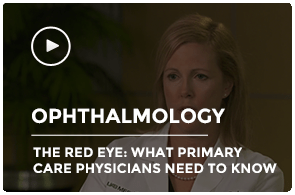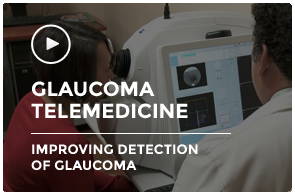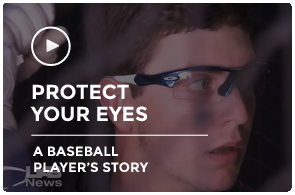Astigmatism is a naturally occurring, treatable condition of the eye that causes blurred or distorted vision. Astigmatism is very common; most people have it to some degree. Slight astigmatisms do not affect vision or require treatment, but more serious cases can cause eye discomfort and headaches. In astigmatism cases, the shape of the eye is not completely round, so when light hits the back of the eye it is refracted more in one direction than the other. This allows only part of the object to be in focus at one time. Objects at any distance can appear blurry and wavy, making it difficult to see fine details.
Astigmatism often is present at birth and it frequently occurs in combination with nearsightedness or farsightedness. Sometimes it sets in after certain types of eye surgery, such as cataract removal. Normally astigmatism can be corrected using glasses, contact lenses, or laser eye surgery. The condition can change over time, requiring updates to corrective lens prescriptions. In children, if left untreated, astigmatism in one eye can cause amblyopia, more commonly referred to as “lazy eye.” It is possible to have astigmatism and not know it, especially in children who may not recognize the symptoms. This underscores the importance of comprehensive eye exams annually.
Conjunctivitis (often called “pink eye”) is inflammation or swelling of the conjunctiva, the thin, clear layer of tissue that lines the inner surface of the eyelid and covers the white part of the eye. It is a common eye condition, especially in children. It may affect one or both eyes. Some forms of conjunctivitis are highly contagious and can spread easily. Conjunctivitis usually is a minor eye infection, though sometimes it can develop into a more serious problem. It can be caused by a viral or bacterial infection, but it also can develop from an allergic reaction to air impurities such as pollen and smoke, chlorine in swimming pools, certain cosmetic ingredients, or other products that touch the eyes, such as contact lenses.
Symptoms can include a gritty feeling in the eye, an itching or burning sensation, excessive tears, discharges from the eye, swollen eyelids, pink discoloration to the white of the eye, and increased light sensitivity. Depending on the type of conjunctivitis and what caused it, treatment can include prescription anti-inflammatory medications and antihistamines, steroid or antibiotic eye drops or ointments, and saline flushing.
Strabismus, or crossed eyes, is a condition that causes the eyes not to line up in the same direction or look at the same place at the same time. Either eye may turn in or out or up or down. An eye may appear turned at all times, or it may be more obvious when the person is tired, stressed, or ill. Though strabismus can be a result of severe farsightedness, it usually is caused by poor eye muscle control.
There are six muscles attached to each eye that control movement, and each muscle receives signals from the brain. Normally, these muscles work together to ensure that both eyes focus on the same object. However, sometimes an issue within the brain – possibly a problem with the nervous system or even a tumor – can affect eye muscle control. When these muscles aren’t working together, two different images can be sent to the brain, causing confusion. In many cases, the brain ignores the image from the weaker eye, eventually leading to vision loss.
Strabismus typically develops in infants and young children by age 3, and most adults who have the condition have had it since childhood. While it is a common belief that children with crossed eyes will outgrow the condition, this is not true. Strabismus will continue to worsen without treatment.
Diabetic retinopathy is a complication from diabetes that affects the eyes. It sometimes leads to partial vision loss and eventually results in blindness. The leading cause of blindness in adults, diabetic retinopathy is caused by damage to or swelling of the blood vessels in the back of the eye (the retina), which is constructed of light-sensitive tissue. In some cases, blood vessels can leak fluid into the eye’s macula causing blurred vision. In other cases, new blood vessels grow abnormally, attaching to the surface of the retina. Anyone with type 1 or type 2 diabetes is at risk but especially longtime diabetics and those with less controlled blood sugar levels.
Ectropion occurs when the eyelid (usually the lower eyelid) is turned out, exposing its inner surface. Ectropion usually is caused by the process of aging and the eyelid’s weakened connective tissue. Other causes may be a birth defect, facial palsy, and scar tissue from a burn. Ectropion may be suspected in the presence of such symptoms as dry painful eyes, excess tearing, outward-turned eyelid, chronic conjunctivitis, keratitis, redness of the lid and white part of the eye. Early in ectropion only one portion of the eyelid is turned out, but if the condition is severe, the eyelid is turned out for its entire length. The diagnosis is reached through examination of the eye and its eyelid with focused light. No special tests usually are necessary. Lubrication with artificial tears may relieve dryness. An outpatient surgical procedure operation is available to tighten the muscles that hold the eyelid in place. Left untreated, the corneal dryness and irritation caused by ectropion may lead to eye abrasions, ulcers, and infections. Corneal ulcers can threaten the eyesight.
Entropion is a condition in which the edge of a lower eyelid turns in against the eyeball. This is an abnormal condition of the lower eyelid that causes the lashes and eyelid skin to rub against the eye causing redness and irritation. It is a common form of eyelid problem in older people, where it usually is caused by a spasm or weakening of the muscles surrounding the lower area of the eye. Entropion also can be caused by a trachoma infection (granular conjunctivitis), which is rare in North America and Europe but is one of the world’s three leading causes of blindness. People should consult their doctor if red eyes occur after they visit an area where this bacterial infection is common (North Africa, South Asia). In early stages symptoms may include excessive tearing, eye discomfort or pain, eye irritation, or redness. Decreased vision may occur if the cornea is damaged. The condition usually can be diagnosed by a doctor without special testing. Treatment includes artificial tears to keep the eye from becoming dry. Surgery to tighten the eyelid of the eye lid’s position is also an option. The prognosis for entropion is usually good if it is treated before eye damage occurs.
Keratoconus is a condition that causes the cornea (the clear, outer lens on the front of the eye) to become thin and bulge outward like a cone. This change in shape causes light rays entering the eye to become less focused, which results in blurry, distorted vision, along with other possible symptoms such as glare and “ghost images.” Keratoconus usually occurs in both eyes. It often starts in the teenage years and slowly progresses through middle age before stabilizing. The condition normally does not lead to blindness, but it can make daily tasks such as reading and driving difficult. There is no known cause for keratoconus, though it may be connected to chronic eye rubbing, certain allergies, and heredity.
Depending on the case and individual factors, the blurry vision often can be corrected with eyeglasses, standard contact lenses or with special customized contact lenses. Keratoconus also can be treated with a procedure called corneal cross-linking (CXL), which uses ultraviolet light and eye drops containing vitamin B2 and has been proven to strengthen the cornea. The CXL procedure often can eliminate or delay the need for a corneal transplantation.
Myopia is the inability to see objects at a distance. Objects may appear blurry or fuzzy until their distance is reduced, at which point details of the image finally become crisp. Those with myopia may be able see the shape of a street sign from a distance, for example, but they may not be able to read the street name until getting closer. Because those with myopia can clearly see images close to them, the condition is commonly referred to as nearsightedness.
Myopia is caused by a refractive error in which the eye is unable to properly refract, or bend light, preventing it from focusing on an image. With normal vision, light bends as it passes through the eye’s cornea and lens and is then focused on the retina, where images are converted to signals that are interpreted by the brain. If the eyeball or cornea is misshapen, the light does not refract properly, which shifts the focus and blurs the image. Myopia is a common eye disorder, diagnosed in nearly one-fourth of the population. For most people, it is easily managed through the use of eyeglasses, contact lenses or refractive surgery. In severe cases, called high myopia, there may be a risk of tearing or developing holes in the retina, which could lead to a detached retina.
Presbyopia is the inability of the eyes to actively focus on nearby objects. This gradual loss or distortion in the near-sighted vision is common as a person ages and becomes most noticeable in the early to mid-40s. It typically worsens at age 65 and older. The lenses in the eyes normally have the ability to expand or contract as needed to focus. Presbyopia occurs as the lenses in older eyes lose their elasticity, or flexibility, and become slightly thicker. It also weakens the muscles around the lenses, which can further contribute to blurry vision.
Presbyopia is not a serious condition, but it can be frustrating. It sometimes is referred to as “long-arm syndrome” because it prompts people to hold reading materials such as books or restaurant menus farther away from the eyes to improve focus. An eye exam can test the refractive power of the eyes (or ability to change focus), acuity (or sharpness of vision), and the condition of the retina and eye muscles. Prescription lenses or over-the-counter reading glasses can help improve focus.
Retinal detachment is a medical emergency. The retina is a layer of tissue at the back of the eye, made up of millions of light-sensitive cells. When the lens at the front of the eye focuses light on the retina, those cells send a visual image to the brain via the optic nerve. This crucial retinal tissue rests on top of another layer of cells that relies on blood vessels to supply oxygen and nourishment to the retina. If the retina is pulled away from that underlying layer, the retinal cells can stop working, leading to blindness. A retinal detachment may be caused by a shrinking vitreous – the fluid inside the eyeball – that tugs on the retinal tissue, and it may follow a tear in the retina that lets the vitreous push underneath the retina.
Clear early warning signs of a retinal detachment include an increase in “floaters,” which are specks or threads that appear to float in the field of vision; an increased number of light flashes in the eye; or a gray veil or curtain that seems to move across the field of vision. A retinal detachment does not hurt. Immediate diagnosis and repair of a retinal detachment by an eye specialist can save the vision. Retinal detachment is more common beyond age 40.
Uveitis is a term used to describe a group of inflammatory diseases that destroy eye tissue. Specifically, it refers to the swelling of a tissue found in the middle layer of the eye, called the uvea. The uvea includes three parts: the colored ring of the eye called the iris, the choroid, and the ciliary body. The choroid and ciliary body are located behind the iris and are not visible without the use of special equipment. Swelling or destruction of eye tissue in each of these three parts of the uvea results from a different type of uveitis, which tend to be named based on where in the uvea the swelling occurs. The most common type is iritis, or anterior uveitis, which is inflammation of the iris. Other types include choroiditis (in the choroid); cyclitis, or intermediate uveitis (in the ciliary body); and pnuveitis (when all three parts of the uvea are infected). When inflammation occurs in the white part of the eye it is known as scleritis, and it is called pars planitis when it occurs in the pars plana, a narrow section of the ciliary body.
Uveitis, in any form, is a serious condition that can lead to partial or complete vision loss if left untreated. Though there may be noticeable signs of uveitis, such as red, aching eyes and light sensitivity, the presence of white blood cells is what ultimately leads to a diagnosis. The inflammation and deterioration of eye tissue occurs when white blood cells invade the uveal tissue, eventually leaking into other parts of the eye.
The specialists at UAB Callahan Eye use the most advanced technology and are known for working together to treat the full range of both common and complex corneal problems. From cataract and corneal surgeries to highly specialized contact lenses, Callahan features the expertise, experience, and cutting-edge equipment needed to treat the most challenging corneal conditions. Patients come here from around the world and nation because we don’t just treat eye disease – we empower patients to take control of their eye health.
Callahan is the only full-service facility in Alabama specializing in the diagnosis and treatment of the eye and one of only a few worldwide that is entirely devoted to advancements in ophthalmology. That reputation is supported by 16 operating rooms dedicated to eye surgery and a 24/7 eye emergency room that is the region’s only Level I Ocular Trauma Center. More than 15,000 surgeries are performed at UAB Callahan Eye Hospital each year, and we conduct more reconstructive eye procedures than any other facility in the world.
Our facility is home to more than two dozen ophthalmologists, many of whom are named among the top doctors in their fields nationally. Callahan is widely recognized for excellence in patient care, having consistently earned prestigious awards from health care consulting group Press Ganey, and in 2017 Callahan was named as one of the “100 Great Places to Work in Healthcare” by Becker’s Hospital Review.
Callahan also is known for pioneering developments in surgical instruments, devices, and procedures used by ophthalmologists across the globe. As part of the UAB Medicine academic medical center, Callahan is actively involved in ongoing research and clinical trials. Many of our ophthalmologists have received funding from prestigious research organizations and institutions and collaborate in clinical care to bring the latest in scientific discovery to our patients.
Care Providers
Videos




Resources
- UAB Callahan Eye Hospital
- UAB Department of Ophthalmology
- American Academy of Ophthalmology
- National Eye Institute
- The Facts About Diabetic Disease
- Diabetic Retinopathy
- Myopia
Related Specialties
Clinical Trials
Speak to your physician about your options and browse the link below for more information
Latest News
View All News-
Jarrod Johnson named CEO of UAB Callahan Eye
September 25, 2024
-
Artist Manjari Sharma explores ritual, identity, memory and mythology in new exhibitions
August 30, 2024
-
Landmark drug trial shows promising results for Pitt-Hopkins syndrome
July 5, 2024
-
Keep the fireworks fun in the sky and out of your eyes
June 28, 2024
-
Too much screen time is a risk to children’s eyes. Here is how to protect their eye health.
May 20, 2024
















